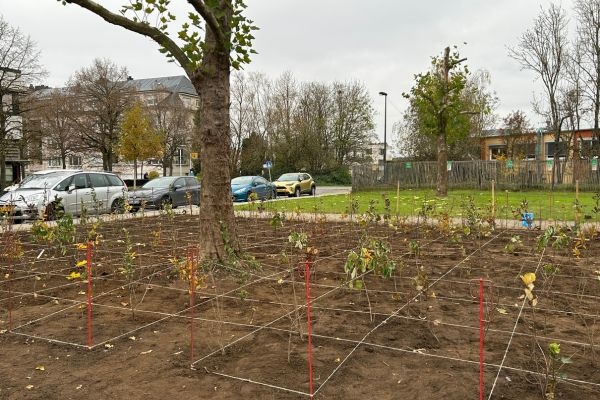 Planting the Tiny Forest in Limpertsberg;
Credit: Helen O'Mahony, Chronicle.lu
Planting the Tiny Forest in Limpertsberg;
Credit: Helen O'Mahony, Chronicle.lu
On Friday 15 November 2024, a “micro-forest” planting ceremony, in recognition of National Tree Day, took place in Luxembourg-Limpertsberg.
Fifteen pupils from Limpertsberg Primary School enthusiastically worked together to dig holes and plant trees under the watchful eyes of Luxembourg’s Minister of the Environment, Climate and Biodiversity, Serge Wilmes, Luxembourg City Mayor Lydie Polfer, Luxembourg City First Alderman Maurice Bauer and City of Luxembourg Parks Department staff.
The urban micro forest (also known as a “tiny forest”) is the first of its kind in the capital and is located at the intersection between Avenue Joseph Sax and Rue Lucien Wercollier in Luxembourg-Limpertsberg. The area was divided into grids and pupils planted approximately three young trees in each grid. Each pupil was presented with a goody bag provided by the City of Luxembourg.
This year’s National Tree Day, which is organised annually by by Fondation Hëllef fir d'Natur, (Help for Nature Foundation), is on Saturday 16 November 2024. The event aims to encourage communities, individuals, organisations and companies to plant trees to combat climate change and preserve biodiversity.
According to the City of Luxembourg: “Thanks to this initiative, some 500 trees and shrubs have been added to the green land register, which now has 23,200 urban and park trees maintained by the Park Service of the City of Luxembourg. The aim of the action was to bring young people closer to nature and the planting of the trees took place in an educational context that also aimed to raise children's awareness of environmental protection. Particularly dense and small in size, these micro-forests have three to five trees and shrubs per m2 and are ideal for development in an urban environment. Far beyond simply beautifying neighbourhoods, these urban forests improve air quality by filtering dust and enriching the air with oxygen, they capture CO2 from the atmosphere, cool streets and public squares by casting shade and humidifying the air, and create a rich habitat for wildlife, not to mention their beneficial effects on the mental and physical health of citizens. Studies have also shown that increasing the number of small and medium-sized green spaces well-distributed over a given area can reduce the formation of heat islands and increase cooling”.









